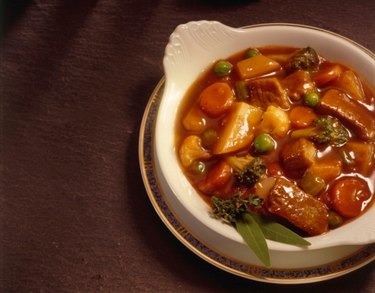
Stewing is a long, slow, moist cooking process similar to braising. It is typically used to tenderize tough cuts of meat, usually beef, pork, bison or buffalo. Stew recipes normally call for more liquid than braising ones and the final dish is conventionally thicker than soup.
Stew Beef Characteristics
Video of the Day
The best stew beef has plenty of marbling and connective tissue to keep it from getting tough during the stewing process. As the fat and tissues slowly melt, they infuse the dish with natural beef flavors and tenderize it. If the stew beef is too lean, it will turn chewy and unpalatable and, if it is cut from a tender part of the cow, it will disintegrate during cooking.
Video of the Day
Common Cuts
Most stew beef is cut from beef chuck or round parts of the cow but any tough cut of beef will work. Avoid top round cuts, as they are too delicate to withstand long cooking. Boneless beef short ribs are also good choices for stewing. Tri tip and flank steak cuts are also acceptable for stewing as long as they are not too thin. You can use cross cut beef shanks or regular beef short ribs, but the bones should be removed before serving the stew.
Precut or Home Cut
Stew meat is typically cut into 3/4 inch to 1 1/2 inch cubes and cooked with vegetables, such as potatoes, carrots, celery and onions cut into similar sizes. You can purchase the meat precut and packaged for convenience or buy a roast and cut it yourself. Precut stew beef is usually more expensive per pound than roasts. If you choose to cut your own, you can be sure each piece has appropriate marbling and is uniform in shape and size.
Beef Stew Tips
When buying beef for stew, figure on 2 1/2 oz. to 3 oz. per serving, so one pound will feed four to five people when served with other stew ingredients. Dredging the beef cubes in seasoned flour and browning them lightly in a small amount of oil before adding the liquid and vegetables adds flavor to the stew as well as seals in the juices of the beef. The browning flour also naturally thickens the liquid during cooking. Barely cover the stew components with water, broth, fruit or vegetable juice, beer, wine or a combination of liquids. After bringing the ingredients to a boil, quickly reduce the heat to a simmer. Keep the heat at a slow simmer to produce the most tender and flavorful beef; boiling will toughen the meat.